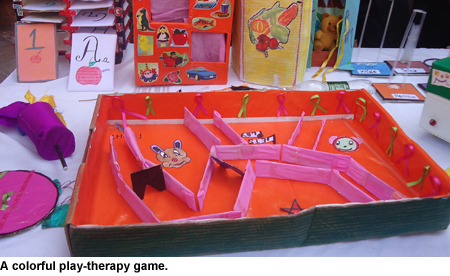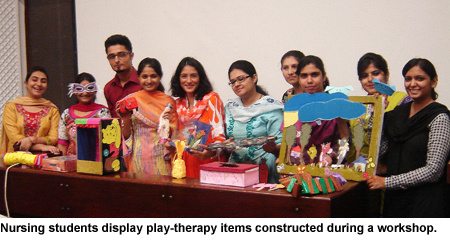Low-cost therapy helps pediatric patients cope with hospitalization.
<
Working in a pediatric setting is a rewarding and most challenging experience. From the perspective of the patients, the hospital is a source of stress. The bright lights, high noise level, painful procedures, bitter flavor of medicines, physical separation from parents and loved ones, unfamiliar hospital routines, and, most importantly, the child’s disease process all serve as sources of toxic stress for pediatric patients. Not every child is resilient to these stresses, and these traumatic experiences affect not only the architecture of a young child’s developing brain but also pose negative impacts on growth, developmental coping, self-management skills, and compliance with the treatment regimen.

Play therapy is one therapeutic intervention that can serve a pivotal role in preparing sick children for hospital routines, informing them about management of their disease processes, relieving anxieties associated with hospitalization, diverting their minds during painful procedures, and promoting their cooperation with diagnostic procedures and treatment plans. The literature shows that play therapy serves as a developmentally appropriate strategy for pediatric patients and aids in reducing patient fears and anxieties. Play therapy also enhances sick children’s cognitive, social, and physical development and promotes compliance and self-management skills (Boyd et al., 2009; Goymour et al., 2000; Hirani, 2013; Hockenberry & Wilson, 2007; Jun-Tai, 2008; Murphy & Garry, 2002).
Age- and disease-specific
As a pediatric nurse educator with expertise in early childhood development, I took the lead in incorporating low-cost play therapy for hospitalized children in the baccalaureate pediatric-nursing curriculum at Aga Khan University. Each year, undergraduate nursing students who take the pediatric-health nursing course at Aga Khan are offered a play-therapy workshop during which they are taught use of low-cost play therapy, based on disease type, for patients in specific age groups. The students take keen interest as they observe preparation of age-appropriate play therapy for sick and hospitalized pediatric patients. For the past few years, we have observed that, on one hand, introduction of this workshop enhances creativity, critical thinking, and problem-solving skills of nursing students, while, on the other hand, providing insight into the feelings of hospitalized pediatric patients who are experiencing multiple stressors.

Overall, incorporating the play-therapy element into the nursing curriculum works very well. Play therapy enables many children with chronic diseases to vent their feelings through pretend play, drawing, and painting. Through puppet shows, doll play, and storytelling, children with oncological disorders who experience the side effects of chemotherapy learn to cope with their disease process and regain self-esteem. Many pediatric patients diagnosed with insulin-dependent diabetes learn to administer insulin injection to dolls and then to themselves, thereby helping to rid them of needle phobia.
Snakes, ladders, rattles, and wind chimes
Play therapy that incorporates socialization and limb movement helps children with fractures and contractures gradually gain mobility. Through use of a specially designed snake-and-ladder game that includes health messages, children with poor eating habits learn the importance of a proper, well-balanced diet. (A healthy diet leads to climbing the ladder, and an unhealthy diet of junk foods results in being bitten by the snake.) Play therapy also works for very young children. Handmade, colorful rattles and wind chimes help stimulate development of sick infants, newborns exposed to phototherapy, and babies in incubators who were born prematurely. These therapeutic tools also promote interaction of infants with caregivers and surrounding environments during hospitalization.

To conclude, play therapy has magical effects on all aspects of health, coping, growth, and development of sick and hospitalized children. Implementation of this intervention is effective for sick children of all ages. Considering the tremendous benefits of play therapy, it is recommended that nursing schools encourage students to design age-appropriate, low-cost play therapy for hospitalized children. In so doing, they will help pediatric patients cope with hospitalization and reduce the adverse effects of toxic stress associated with their disease processes and hospitalization. RNL
Shela Akbar Ali Hirani, MScN, RN, IBCLC, Advanced Diploma in ECD, is assistant professor, Aga Khan University School of Nursing and Midwifery in Karachi, Pakistan.
References:
Boyd, M., Lasserson, T. J., McKean, M. C., Gibson, P. G., Ducharme, F. M., & Haby, M. (2009). Interventions for educating children who are at risk of asthma-related emergency department attendance. Cochrane database of systematic reviews, 2: Art. No. CD001290. DOI: 10.1002/14651858.CD001290.pub2
Glazier, T. (1997). Play therapy for the children in the emergency department. Australian Emergency Nursing Journal, 1 (2), 52-53.
Hirani, S. A. (2013). Use of play therapy in educating asthmatic and diabetic pediatric patients: A pilot clinical project at a private tertiary setting in Karachi, Pakistan. International Journal of Nursing Care, 1 (1), 83-87.
Hockenberry, M., & Wilson, D. (2007). Wong’s nursing care of infants and children. (8th Ed.). New Delhi, India: Mosby.
Jun-Tai, N. (2008). Play in hospital. Pediatrics and Child Health, 18 (5), 233-237.
Murphy, J. E., & Garry, L. (2002). The efficacy of intensive individual play therapy for chronically ill children. International Journal of Play Therapy, 11 (1), 117-140.